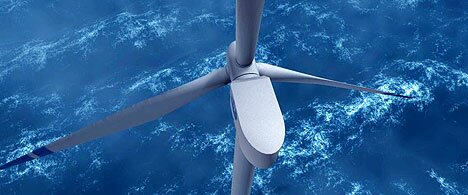Bloom Box: What is it and how does it work? / The Christian Science Monitor – CSMonitor.com
22-Feb-10
So what is Bloom Box?
It’s a collection of fuel cells – skinny batteries – that use oxygen and fuel to create electricity with no emissions.
Fuel cells are the building blocks of the Bloom Box. They’re made of sand that is baked into diskette-sized ceramic squares and painted with green and black ink. Each fuel cell has the potential to power one light bulb. The fuel cells are stacked into brick-sized towers sandwiched with metal alloy plates.
The fuel cell stacks are housed in a refrigerator-sized unit – the Bloom Box. Oxygen is drawn into one side of the unit, and fuel (fossil-fuel, bio-fuel, or even solar power can be used) is fed into the other side. The two combine within the cell and produce a chemical reaction that creates energy with no burning, no combustion, and no power lines.
About 64 stacks of fuel cells could power a small business like a Starbucks franchise, according to Sridhar’s 60 Minutes interview.
Working with an investment of around $400 million, aerospace engineer K.R. Sridhar spent close to a decade inventing the Bloom Box. It grew, he explained to 60 Minutes, from a device he originally invented to produce oxygen on Mars. When NASA scrapped the Mars mission, Sridhar reversed his Mars machine, pumping oxygen in, instead of making oxygen, he said.
Sridhar already has some 20 well-known customers, including Google, FedEx, Walmart, Staples, and Ebay. The corporate boxes cost about $700,000 to $800,000.
The lack of details is pinging my crank meter, but they have some smart backers, so I’m withholding judgment until they debut their full website.
Posted via web from crasch’s posterous
StatoilHydro to build first full scale offshore floating wind turbine

StatoilHydro has decided to build the world’s first full scale floating wind turbine, Hywind, and test it over a two-year period offshore Karmøy. The The company is investing approximately 400 million NOK [~$60 million]. Planned startup is autumn 2009.
StatoilHydro has developed HyWind based on floating concrete constructions familiar from North Sea oil installations. In this way we exploit the wind where it is strongest and most consistent — far out to sea.
The project combines known technology in an innovative way. A 2.3 MW wind turbine is attached to the top of a so-called Spar-buoy, a solution familiar from production platforms and offshore loading buoys.
Bilde“If we succeed, then we will have taken a major step in moving the wind power industry offshore”, says Alexandra Bech Gjørv, head of New Energy in StatoilHydro. (Photo: Øyvind Hagen, StatoilHydro)
“We have drawn on our offshore expertise from the oil and gas industry to develop wind power offshore,” says Alexandra Bech Gjørv, head of New Energy in StatoilHydro.
The rotor blades on the floating wind turbine will have a diameter of 80 metres, and the nacelle will tower some 65 metres above the sea surface. The floatation element will have a draft of some 100 metres below the sea surface, and will be moored to the seabed using three anchor points. The wind turbine can be located in waters with depths ranging from 120 to 700 metres.
“Taking wind turbines to sea presents new opportunities. The wind is stronger and more consistent, areas are large and the challenges we are familiar with from onshore projects are fewer,” says Alexandra Bech Gjørv.
Wind Power That Floats
05-Apr-08
Wind Power That Floats:
Offshore wind-farm developers would love to build in deep water more than 32 kilometers from shore, where stronger and steadier winds prevail and complaints about marred scenery are less likely. But building foundations to support wind turbines in water deeper than 20 meters is prohibitively expensive. Now, technology developers are stepping up work in floating turbines to make such farms feasible.
Several companies are on their way to demonstrating systems by borrowing heavily from oil and gas offshore platform technology. In December, the Dutch floating-turbine developer Blue H Technologies launched a test platform off Italy’s southern coast; last month, the company announced its plans to install an additional test turbine off the coast of Massachusetts, and possibly begin constructing a full wind farm off the Italian coast, next year. Close behind is SWAY, based in Bergen, Norway, which raised $29 million last fall and plans to field a prototype of its floating wind turbine in 2010.
Via futurepundit
